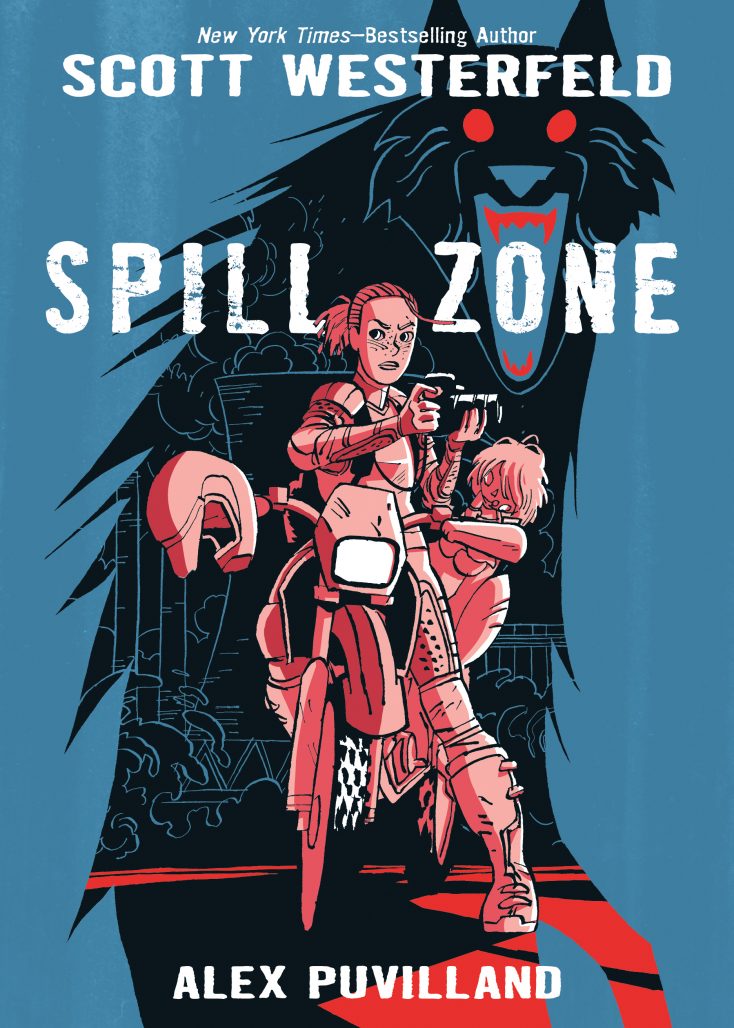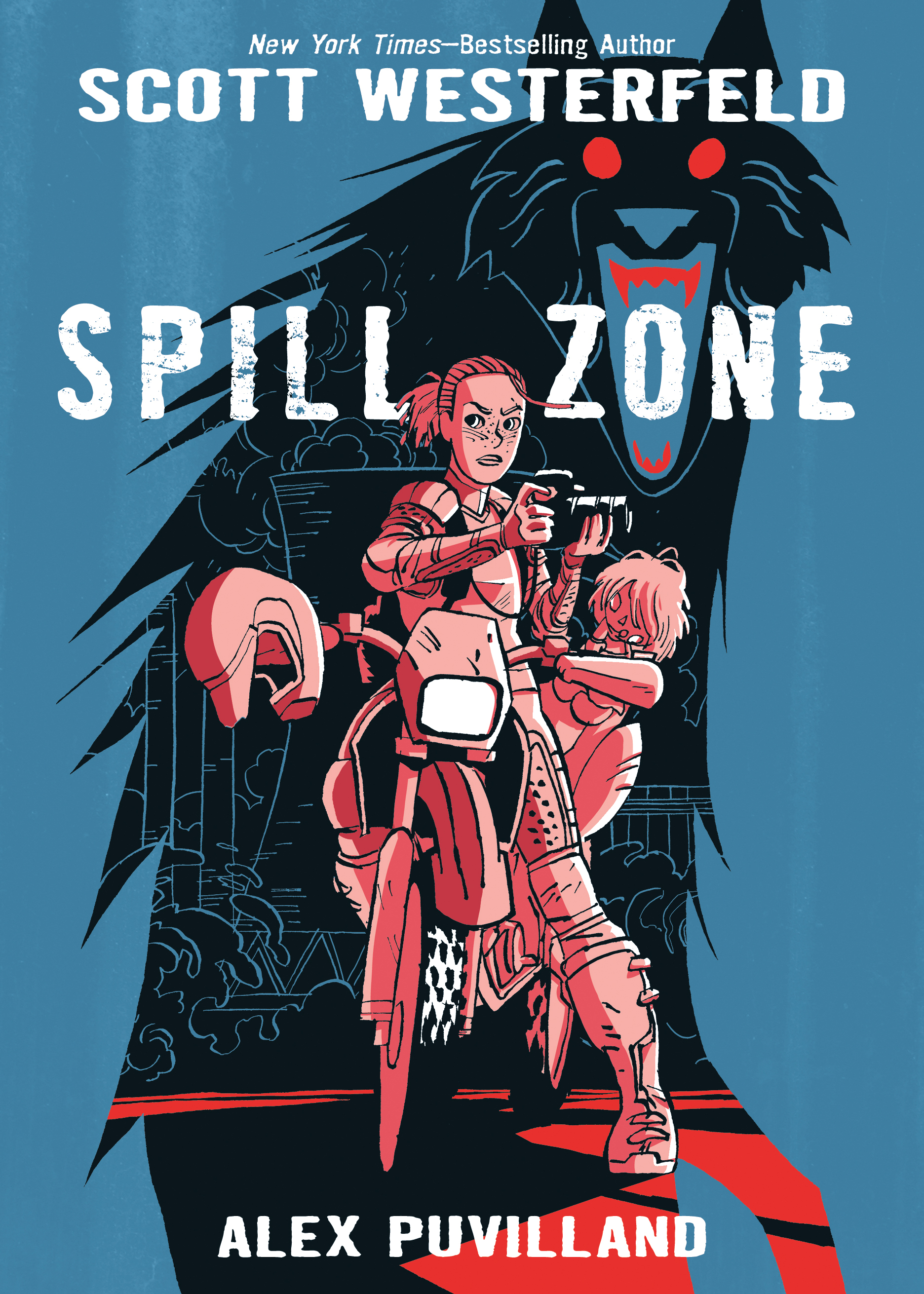
I was fortunate to speak with writer Scott Westerfeld about his writing, story direction, and the process it took to get this book published.
–
What can you tell us about Spill Zone?
It’s about a young woman, Addison, whose hometown and family were destroyed by a mysterious event three years ago. Her parents were lost in the Spill, and her little sister hasn’t spoken since (except for psychic exchanges with her creepy doll, Vespertine). Addison supports herself and Lexa by sneaking into the Zone and taking photographs of the strange creatures and other phenomena left behind by the Spill. So basically it’s about loss, making art, hanging onto family, and getting away from monsters on a motorcycle.
Where did you get the idea for this graphic novel?
Partly from something called the Goiania Accident, which took place in Brazil in 1987.
Scrap thieves snuck into a private radiotherapy institute and stole a teletherapy unit—a device for zapping cancer tumors. After they disassembled it, the radioactive element was spread around by townsfolk enraptured by its strange glow. In the end, 249 people, three buses, forty-two houses, fourteen cars, and five pigs were contaminated. This story, about a small city being devastated by a wondrous but deadly technology they didn’t understand, has always stuck with me. I also spent a lot of time as a college student sneaking into abandoned buildings. So lost and forgotten places has always been one of my favorite places for stories to happen.

From start to finish, how long did Spill Zone take? Have you worked on other comics or stories before?
Ten years! I started writing the script in 2006, but soon realized that my prose-novel chops didn’t translate into comics. So I sold the graphic-novel rights to Uglies, with the provision that I’d get to outline the novel and work with the writer, the amazing Devin Grayson. (In other words, I tricked a publisher into paying me to learn to write comics.) Seeing those Uglies adaptations go from outline to pencils to inks to finals gave me the experience I needed to get back to Spill Zone. So it was a long labor of love.
How has it been like working with First Second? What did they bring to the table?
First, they hooked me up with Alex Puvilland and Hilary Sycamore, who’ve done an amazing job bringing the Zone and the characters to life. First Second also extended the story, taking my script for about 80 pages and stretching it out for the 220 page of the first book, giving it a much grander pace with more space for amazing visuals. Also, FS makes great packages, as anyone who picks up the hardcover will discover.
What were some of the most difficult parts of getting this book made?
The main challenge was keeping my filthy prose out of the way. Once I realized that every word I typed was covering up Alex’s brilliant artwork, I went on a strict regime of spare and crystalline dialog. When I write prose novels, I usually build up from a dialog spine. But here I was chopping away words whenever I could. It was a strange reversal for me, but probably good for my brain. (We’ll see what happens when I go back to regular novels!)
Can you tell us, or hint at, what exactly is “Vespertine”?
If you want to know what’s really going on, always listen to the twelve-year-old girls. They know the score. As Lexa keeps saying, “She’s the beautiful Princess Vespertine! Everyone wants to dance with her!”
The way that the panels are placed just flows so well with the “wrongness” of the Spill Zone, as do the few awkward angle shots. How long did it take to get the art for this book “just right”?
My original idea was to have the “normal” world be black and white and the Zone to be in color (like The Wizard of Oz, I guess). But too much of the book would have been in grays, so we decided to give the regular world normal colors, and crank the Zone up to eleven!
Hilary and Alex exchange a lot of emails (which I mostly don’t understand) about how the colors in the Zone bleed out of their spaces. The end result looks amazing, though, as if reality is coloring outside the lines. Or like a horror video game when it glitches out and becomes more horrible than the designers intended. And this sensibility extends to the art. As you spotted, the angles in the Zone are as weird as possible. Addison is an artsy photographer, and one who must always be ready to run for her life, so we wanted her style to bleed out into the comic itself.
How many stories do you have planned for the Spill Zone?
At the moment we’re just doing two books, which will complete Addison’s story. But I think there’s room to look at how the Spills (both the one in upstate NY and in North Korea) have changes the world around them. I’d want to find new characters, however, or focus on the tangential characters of these two books.
If you could go back, what would you have done differently in the process?
I learn more from mistakes than getting things right the first time, so probably nothing. (Except I might format my scripts better from the beginning. Prose novels are SO EASY to format compared to anything else.
–
I thoroughly thought Scott and Alex did a wonderful job in the telling and portrayal of this alluring tale. Check out First Second’s Spill Zone at your local bookstore or preferred online shopping experience, releasing today. For more interesting graphic novels, visit First Second at www.firstsecondbooks.com, and to know more about author Scott Westerfeld, check him out at www.scottwesterfeld.com.








Comments are closed.